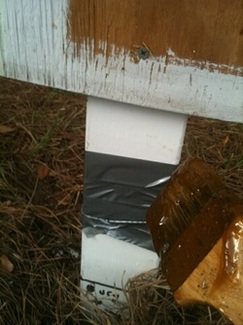Tunnel-nest maintenance
Whether your nests are wooden blocks, twig bundles, or other materials, in order to be sustainable they will need routine management and regular replacement. This is important to prevent the buildup of bee parasites and diseases that affect the developing brood.
Try the following approaches to reduce natural damage and disease problems:
Dealing With Woodpeckers
To protect against woodpecker damage, you might want to store your nests in an unheated building at the end of the season. Alternatively, you can protect nests over the winter by surrounding them with hardware cloth or chicken wire. Be sure to remove it before nesting resumes, as it can disorient nesting bees and damage their wings.
Disinfect Nest Blocks
Line the tunnels of wooden nest blocks with tight-fitting removable paper straws. At the end of the nesting season (autumn), gently remove the straws (with bees in them) and place them in a ventilated container stored either in a refrigerator or in an unheated barn or garage. Disinfect nest blocks after the straws have been removed by submerging them in a 1:3 bleach-water solution for a few minutes, ensuring that no air bubbles remain in the holes. In the spring, place the old straws inside an emergence chamber, and place new straws inside the disinfected block. |

© Donna Brown
|

|
Dealing With Ants
Ants can be a problem as they forage in your nest for pollen, prey and immature bees and wasps. We use tanglefoot, a non-toxic mechanical control which prevents the ants from climbing up a post or down a wire. You can also try oil based jellies or other products but avoid anything toxic and avoid chemicals that would kill the ants as these same chemicals may kill the bees or wasps.
Renew Blocks & Bundles
Every two years, phase out wooden and adobe nest blocks and stem bundles by placing them inside an emergence chamber at the beginning of the season when the adults are active. This is a dark container such as a lightproof wooden box, a dark-colored plastic bucket with a tight-fitting lid, or even a sealed milk carton that has been spray-painted black to reduce light infiltration.
|
Drill a single 3/8-inch (10mm) exit hole in the bottom of the light-proof container, and set the entire contraption outside, adjacent to a new nest block or stem bundle. As bees emerge from the old nest, they are attached to the light of the exit hold and emerge to find the new nest hanging nearby. Locating the escape hole on the bottom of the dark container means the bees can crawl out, rather than attempting to fly out. At the end of the season, remove the old nest block or stem bundle from the emergence box and dispose of it.
Offer Smaller Blocks & Bundles Around Property
Create multiple small nest blocks or stem bundles with only a few nest tunnels (4 or 6), and scatter them across your property, at least 25 feet (8.0 m) or more apart. This prevents the unnaturally high populations
of bees found at nest blocks with many holes, and it mimics natural conditions of limited, spatially separated nest sites. These smaller nests also decompose more rapidly. They can simply deteriorate naturally as you add new small nests to the landscape periodically.